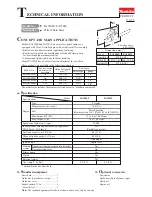
English
8
battery pack in a warm environment such as in a metal
shed or an uninsulated trailer.
3. If the battery pack does not charge properly:
a. Check operation of receptacle by plugging in a lamp
or other appliance;
b. Check to see if receptacle is connected to a light
switch which turns power off when you turn out
the lights;
c. Move the charger and battery pack to a location
where the surrounding air temperature is
approximately 65 °F – 75 °F (18 °C – 24 °C);
d. If charging problems persist, take the tool, battery
pack and charger to your local service center.
4. The battery pack should be recharged when it fails to
produce sufficient power on jobs which were easily
done previously. DO NOT CONTINUE to use under these
conditions. Follow the charging procedure. You may
also charge a partially used pack whenever you desire
with no adverse effect on the battery pack.
5. Foreign materials of a conductive nature such as, but
not limited to, grinding dust, metal chips, steel wool,
aluminum foil, or any buildup of metallic particles
should be kept away from charger cavities. Always
unplug the charger from the power supply when there
is no battery pack in the cavity. Unplug the charger
before attempting to clean.
6. Do not freeze or immerse the charger in water or any
other liquid.
Charger Cleaning Instructions
WARNING:
Shock hazard. Disconnect the charger
from the AC outlet before cleaning. Dirt and grease
may be removed from the exterior of the charger using
a cloth or soft non-metallic brush. Do not use water or
any cleaning solutions.
Wall Mounting
These chargers are designed to be wall mountable or to
sit upright on a table or work surface. If wall mounting,
locate the charger within reach of an electrical outlet,
and away from a corner or other obstructions which may
impede air flow. Use the back of the charger as a template
for the location of the mounting screws on the wall. Mount
the charger securely using drywall screws (purchased
separately) at least 1” (25.4 mm) long, with a screw head
diameter of 0.28–0.35” (7–9 mm), screwed into wood to an
optimal depth leaving approximately 7/32” (5.5 mm) of the
screw exposed. Align the slots on the back of the charger
with the exposed screws and fully engage them in the slots.
Versatrack™
CRAFTSMAN chargers can be mounted to the wall using
CRAFTSMAN Versatrack™ Trackwall. Hooks and accessories
are sold separately. Please refer to the Versatrack™ Trackwall
accessory sheet for further information.
ASSEMBLY AND ADJUSTMENTS
WARNING: To reduce the risk of serious personal
injury, turn unit off and remove the battery pack
before making any adjustments or removing/
installing attachments or accessories.
An
accidental start-up can cause injury.
Intended Use
This circular saw is design for do-it-yourself, wood-
cutting applications.
WARNING:
Do not cut any metals, masonry, glass,
tile or plastic with this saw. A dull blade will cause
slow, inefficient cutting overload on the saw motor,
excessive splintering, and could increase the possibility
of kickback.
• DO NOT use any abrasive wheels.
• Use only blades designed for wood cutting.
WARNING:
Cutting sap coated wood, and
other materials may cause melted substances to
accumulate on the blade tips and the body of the saw
blade, increasing the risk of the blade overheating and
binding while cutting.
DO nOT
use under wet conditions or in presence of
flammable liquids or gases.
DO nOT
let children come into contact with the tool.
Supervision is required when inexperienced operators use
this tool.
WARNING:
To reduce the risk of injury, always
remove battery from saw before any of the following
adjustment operations.
Attaching and Removing the Blade (Fig. A, B)
1. Retract lower guard and assemble saw blade
6
and
outer blade clamp washer
11
as shown in Figure B
14
Fig. B
12
6
17
11
2. Depress the spindle lock button
14
while turning the
blade retaining bolt
12
with the hex wrench
17
until
the blade lock engages and the blade stops rotating.
nOTE:
Hex wrench is stored on the saw as shown in
Figure A.
3. Tighten the blade retaining bolt securely with the
hex wrench.
nOTE:
Bolt has a right-handed thread. To loosen, turn











































